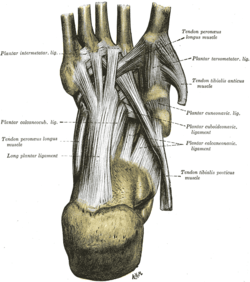Plantar calcaneonavicular ligament
| Plantar calcaneonavicular ligament | |
|---|---|
 Ligaments of the medial aspect of the foot. (Plantar calcaneonavicular ligament labeled at bottom center.) | |
 Ligaments of the sole of the foot, with the tendons of the Peronæus longus, Tibialis posterior and Tibialis anterior muscles. (Plantar calcaneonavicular ligament labeled at right, second from the bottom.) | |
| Details | |
| From | calcaneus |
| To | navicular |
| Identifiers | |
| Latin | ligamentum calcaneonaviculare plantare |
| TA | A03.6.10.203 |
| FMA | 44254 |
The plantar calcaneonavicular ligament (also known as the spring ligament) is a ligament on the underside of the foot that connects the calcaneus with the navicular bone.
Structure
The plantar calcaneonavicular ligament is a broad and thick band of fibers, which connects the anterior margin of the sustentaculum tali of the calcaneus to the plantar surface of the navicular.
This ligament not only serves to connect the calcaneus and navicular, but supports the head of the talus, forming part of the articular cavity in which it is received.
The dorsal surface of the ligament presents a fibrocartilaginous facet, lined by the synovial membrane, and upon this a portion of the head of the talus rests.
Its plantar surface is supported by the tendon of the tibialis posterior; its medial border is blended with the forepart of the deltoid ligament of the ankle-joint.
The plantar calcaneonavicular ligament helps to maintain the medial longitudinal arch of the foot, and by providing support to the head of the talus, bears the major portion of the body weight.
See also
References
This article incorporates text in the public domain from the 20th edition of Gray's Anatomy (1918)
External links
- lljoints at The Anatomy Lesson by Wesley Norman (Georgetown University) (soleoffootligaments)
- http://www.ithaca.edu/faculty/lahr/LE2000/ankle%20pics/5medankle-new.jpg